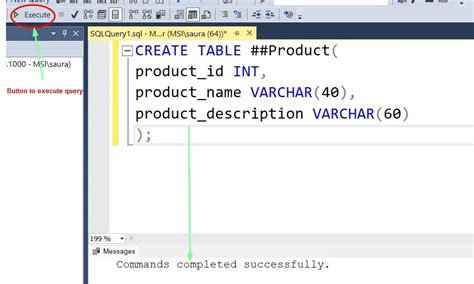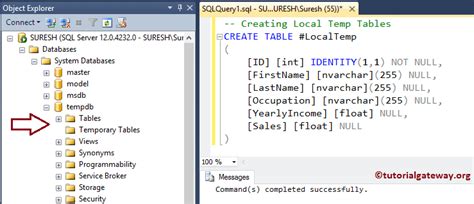SQL temporary tables, also known as temp tables, are used to store and manipulate data temporarily while a database session is active. They are particularly useful in complex queries, stored procedures, and triggers, allowing for intermediate results to be stored and processed without affecting the permanent tables. Here, we'll explore five ways to create a temporary table in SQL, highlighting their syntax, advantages, and scenarios where they are most applicable.
Introduction to Temporary Tables

Temporary tables are database objects that are automatically deleted when the session that created them is closed. They can be used like regular tables, supporting most operations such as SELECT, INSERT, UPDATE, and DELETE. SQL Server, in particular, supports two types of temporary tables: local temporary tables (which are prefixed with a single ‘#’) and global temporary tables (which are prefixed with ‘##’).
Key Points
- Temporary tables are used for temporary storage and manipulation of data.
- They are automatically deleted at the end of a session.
- SQL Server supports local and global temporary tables.
- Temporary tables can be created using the SELECT INTO statement or the CREATE TABLE statement.
- They are useful in complex queries, stored procedures, and triggers.
Method 1: Using SELECT INTO Statement

The SELECT INTO statement can be used to create a temporary table by selecting data from an existing table. This method is straightforward and creates the temporary table based on the structure of the data being selected.
SELECT *
INTO #TempTable
FROM ExistingTable
WHERE Condition;
Advantages and Limitations
This method is advantageous for quickly creating a temporary table with the exact structure needed for the selected data. However, it does not allow for specifying data types or constraints explicitly, which might be a limitation in some scenarios.
Method 2: Using CREATE TABLE Statement
The CREATE TABLE statement offers more control over the creation of temporary tables, allowing for the specification of data types, constraints, and indexes. This method is particularly useful when the structure of the temporary table needs to be predefined or when the temporary table will be used extensively.
CREATE TABLE #TempTable (
Column1 DataType,
Column2 DataType,
CONSTRAINT PK_TempTable PRIMARY KEY (Column1)
);
Specifying Data Types and Constraints
Specifying data types and constraints is crucial for ensuring data integrity and performance. By using the CREATE TABLE statement, you can define the temporary table’s structure to exactly match your needs, including the ability to add primary keys, foreign keys, and unique constraints.
| Method | Description |
|---|---|
| SELECT INTO | Creates a temporary table based on selected data. |
| CREATE TABLE | Offers more control over temporary table creation. |

Method 3: Creating Global Temporary Tables
Global temporary tables are similar to local temporary tables but are visible to all sessions. They are created using the ‘##’ prefix and are automatically dropped when the last session using them is closed.
CREATE TABLE ##GlobalTempTable (
Column1 DataType,
Column2 DataType
);
Use Cases for Global Temporary Tables
Global temporary tables are useful when data needs to be shared across multiple sessions, such as in distributed processing scenarios or when several procedures need access to the same temporary data.
Method 4: Using Temporary Table Variables

Table variables are another form of temporary data storage in SQL Server, declared using the ‘@’ symbol. They are similar to temporary tables but have some differences in terms of usage and limitations.
DECLARE @TempTableVariable TABLE (
Column1 DataType,
Column2 DataType
);
Performance Considerations
Table variables can offer better performance than temporary tables in certain scenarios, especially when dealing with a small number of rows, due to their simpler structure and lack of logging. However, they do not support all the features of temporary tables, such as indexes.
Method 5: Creating Temporary Tables in Stored Procedures
Temporary tables can be created within stored procedures to encapsulate complex logic and improve performance by minimizing the number of database operations. This method is particularly useful for tasks that require intermediate data manipulation.
CREATE PROCEDURE MyStoredProcedure
AS
BEGIN
CREATE TABLE #TempTable (
Column1 DataType,
Column2 DataType
);
-- Procedure logic using the temporary table
DROP TABLE #TempTable;
END;
Best Practices for Temporary Tables in Stored Procedures
When using temporary tables in stored procedures, it’s essential to follow best practices such as explicitly dropping the temporary table when it’s no longer needed to avoid cluttering the tempdb database and to ensure resource efficiency.
What is the main difference between local and global temporary tables in SQL Server?
+Local temporary tables are visible only to the session that created them and are automatically dropped when the session is closed. Global temporary tables are visible to all sessions and are dropped when the last session using them is closed.
Can temporary tables be used in views?
+No, temporary tables cannot be used in views because views are virtual tables based on the result of a SELECT statement, and temporary tables do not exist until they are created by a session.
How do I optimize the performance of temporary tables?
+Optimizing the performance of temporary tables involves proper indexing, avoiding unnecessary data type conversions, minimizing the number of rows, and ensuring efficient data insertion and retrieval methods.
In conclusion, temporary tables in SQL offer a versatile and powerful tool for managing and manipulating data temporarily. By understanding the different methods of creating temporary tables, including their advantages, limitations, and use cases, developers and database administrators can leverage these tools to improve the efficiency, scalability, and reliability of their database operations.
